Effect of Annular Gas–Liquid Two-Phase Flow on Lateral Vibration of Drill String in Horizontal Drilling for Natural Gas Hydrate
Abstract
1. Introduction
2. Derivation of the Lateral Vibration Model of the Drill String System
2.1. Force Analysis of Drill String Element
2.2. Force Analysis of Fluid Element in Drill String
2.3. Force Analysis of Annular Fluid Element
2.4. Forces Fpx and Fpz Caused by the Pressure and Gravity
2.5. Inviscid Hydrodynamic Force
2.6. Forces of Frictional Viscous
2.7. Force Balance Equation of Annular Fluid Element
2.8. Lateral Vibration Model of Drill String System
2.9. Boundary Conditions
2.10. Dimensionless Equation of Motion
3. Method of Solution
Galerkin Method
4. Numerical Results
4.1. Effect of Annular Fluid Velocity on the Stability of Drill String System
4.2. Effect of Annular Fluid Gas Content on Stability of Drill String System
5. Experimental Study
5.1. Experimental Apparatus and Procedure
5.2. Experiment Result
6. Discussion
7. Conclusions
Author Contributions
Funding
Data Availability Statement
Conflicts of Interest
Nomenclature
| L | Length of drill string (m) |
| Ui | Drilling fluid velocity in drill string (m/s) |
| Uo | Annular fluid velocity (m/s) |
| TL | Axial force at bottom (N) |
| Q | Lateral shear force in the drill string (N) |
| Mt | Mass of drill string element (kg) |
| T | Axial force of drill string section (N) |
| y | Lateral deflection (m) |
| Ai | Cross-sectional area of drill string internal (m2) |
| Pi | Pressure of the fluid inside the drill string (Pa) |
| Mif | Mass of the fluid inside the drill string (kg) |
| Fpx, Fpy | Component forces caused by pressure and gravity (N) |
| FL, FN | Frictional viscous forces (N) |
| FA | Lateral inviscid hydrodynamic force (N) |
| Po | Annular pressure (Pa) |
| Ao | Cross-sectional area of drill string external (m2) |
| Ach | Annular cross-sectional area (m2) |
| Do | Drill string outer diameter (m) |
| Dch | Wellbore inner diameter (m) |
| Stot | Total wetted area (m2) |
| So | Wet area outside the drill string (m2) |
| Dh | Hydraulic diameter of the annular channel flow |
| ρo | Gas–liquid mixture density (kg/m3) |
| ρi | Drilling fluid density (kg/m3) |
| ρg | Natural gas density (kg/m3) |
| χ | Added mass coefficient (-) |
| S | Stokes number (-) |
| Cf, k | Viscous damping coefficients (-) |
| v | Kinematic viscosity of annular fluid (m2/s) |
| Ω | Circular frequency of oscillation (rad/s) |
| α | Gas content (-) |
| Fin | Normal hydrodynamic force generated by internal flow (N) |
| Fit | Tangential hydrodynamic force generated by internal flow (N) |
| Fen | Normal hydrodynamic force generated by external flow (N) |
| Fet | Tangential hydrodynamic force generated by external flow (N) |
| E | Elastic modulus of drill string (GPa) |
| I | Moment of inertia of drill string (m4) |
| Ff | The total friction force applied to the drill string element (N) |
| M | Mass matrix |
| C | Damping matrix |
| K | Stiffness matrix |
References
- Matsuzawa, M.; Terao, Y.; Hay, B.; Wingstrom, L.; Duncan, M.; Ayling, I. A completion system application for the world’s first marine hydrate production test. In Proceedings of the Offshore Technology Conference, Houston, TX, USA, 5–8 May 2014. [Google Scholar]
- Seales, M.; Silva, J.M.-D.; Ertekin, T.; Wang, J.Y. An Investigation Into the Occurrence of Hydrate-Bearing Sediments Offshore the East Coast of Trinidad and Tobago. SPE J. 2016, 21, 1782–1792. [Google Scholar] [CrossRef]
- Han, D.; Wang, Z.; Song, Y.; Zhao, J.; Wang, D. Numerical analysis of depressurization production of natural gas hydrate from different lithology oceanic reservoirs with isotropic and anisotropic permeability. J. Nat. Gas Sci. Eng. 2017, 46, 575–591. [Google Scholar] [CrossRef]
- Yu, L.; Xu, Y.; Gong, Z.; Huang, F.; Zhang, L.; Ren, S. Experimental study and numerical modeling of methane hydrate dissociation and gas invasion during drilling through hydrate bearing formations. J. Pet. Sci. Eng. 2018, 168, 507–520. [Google Scholar] [CrossRef]
- Fang, T.; Ren, F.; Liu, H.; Zhang, Y.; Cheng, J. Progress and development of particle jet drilling speed-increasing technology and rock-breaking mechanism for deep well. J. Pet. Explor. Prod. Technol. 2021, 12, 1697–1708. [Google Scholar] [CrossRef]
- Michael, D.M.; Arthur, H.J. Exploration and Production of Oceanic Natural Gas Hydrate, 1st ed.; Springer International Publishing: Cham, Switzerland, 2016; pp. 9–11. [Google Scholar]
- Farahani, M.V.; Guo, X.; Zhang, L.; Yang, M.; Hassanpouryouzband, A.; Zhao, J.; Yang, J.; Song, Y.; Tohidi, B. Effect of thermal formation/dissociation cycles on the kinetics of formation and pore-scale distribution of methane hydrates in porous media: A magnetic resonance imaging study. Sustain. Energy Fuels 2021, 5, 1567–1583. [Google Scholar] [CrossRef]
- Farahani, M.V.; Aliakbar, H.; Yang, J.H.; Bahman, T. Insights into the climate-driven evolution of gas hydrate-bearing permafrost sediments: Implications for prediction of environmental impacts and security of energy in cold regions. RSC Adv. 2021, 11, 14334–14346. [Google Scholar] [CrossRef] [PubMed]
- Wang, B.; Wang, L.; Liu, X.; Ren, F. Bifurcation Diagram and Dynamic Response of a Drill String Applied in NGH Drilling. Processes 2022, 10, 1111. [Google Scholar] [CrossRef]
- Huang, X.Z.; Du, S.H. Status and prospect supply and demand trading of global natural gas and LNG. Oil Gas Storage Transp. 2018, 38, 12–19. [Google Scholar]
- Du, Q.; Liu, Y.; Hou, J.; Shi, L.; Wang, W.; Zhou, K. Investigation on the Secondary Generation of Natural Gas Hydrates in Horizontal Wellbore Caused by Pressure Jump during the Depressurization Development of Hydrate Bearing Layers. Geofluids 2020, 2020, 8815455. [Google Scholar] [CrossRef]
- Huang, Y.F.; Yue, Z.R.; Hu, X.Y. Characteristics of AMT response of anisotropic natural gas hydrate reservoirs in permafrost regions. Chin. J. Geophys. 2018, 61, 2629–2640. [Google Scholar]
- Chazallon, B.; Rodriguez, C.; Ruffine, L.; Carpentier, Y.; Donval, J.-P.; Ker, S.; Riboulot, V. Characterizing the variability of natural gas hydrate composition from a selected site of the Western Black Sea, off Romania. Mar. Pet. Geol. 2021, 124, 104785. [Google Scholar] [CrossRef]
- Majid, A.A.; Wu, D.T.; Koh, C.A. A Perspective on Rheological Studies of Gas Hydrate Slurry Properties. Engineering 2018, 4, 321–329. [Google Scholar] [CrossRef]
- Wang, B.; Wang, Z.; Wang, L.; Sun, P. Effect of Annular Gas-Liquid Two-Phase Flow on Dynamic Characteristics of Drill String. Shock Vib. 2021, 2021, 9976164. [Google Scholar] [CrossRef]
- Chong, Z.R.; Yang, S.H.B.; Babu, P.; Linga, P.; Li, X.-S. Review of natural gas hydrates as an energy resource: Prospects and challenges. Appl. Energy 2016, 162, 1633–1652. [Google Scholar] [CrossRef]
- Tang, L.; Zhu, X. Effects of the Difference Between the Static and the Kinetic Friction Coefficients on a Drill String Vibration Linear Approach. Arab. J. Sci. Eng. 2015, 40, 3723–3729. [Google Scholar] [CrossRef]
- Khajiyeva, L.; Kudaibergenov, A. The effect of gas and fluid flows on nonlinear lateral vibrations of rotating drill strings. Commun. Nonlinear Sci. 2018, 59, 565–579. [Google Scholar] [CrossRef]
- Zhu, X.; Liu, W. The effects of drill string impacts on wellbore stability. J. Pet. Sci. Eng. 2013, 109, 217–229. [Google Scholar] [CrossRef]
- Huang, T.; Dareing, D.W. Buckling and Lateral Vibration of Drill Pipe. J. Eng. Ind. 1968, 90, 613–619. [Google Scholar] [CrossRef]
- McIvor, I.K.; Bernard, J.E. The Dynamic Response of Columns Under Short Duration Axial Loads. J. Appl. Mech. 1973, 40, 688–692. [Google Scholar] [CrossRef]
- Nandakumar, K.; Wiercigroch, M. Galerkin projections for state-dependent delay differential equations with applications to drilling. Appl. Math. Model. 2013, 37, 1705–1722. [Google Scholar] [CrossRef]
- Wang, R.; Liu, X.; Song, G.; Zhou, S. Non-Linear Dynamic Analysis of Drill String System with Fluid-Structure Interaction. Appl. Sci. 2021, 11, 9047. [Google Scholar] [CrossRef]
- Paı¨doussis, M.; Luu, T.; Prabhakar, S. Dynamics of a long tubular cantilever conveying fluid downwards, which then flows upwards around the cantilever as a confined annular flow. J. Fluids Struct. 2008, 24, 111–128. [Google Scholar] [CrossRef]
- Moditis, K.; Paidoussis, M.; Ratigan, J. Dynamics of a partially confined, discharging, cantilever pipe with reverse external flow. J. Fluids Struct. 2016, 63, 120–139. [Google Scholar] [CrossRef]
- Zhu, K.; Chung, J. Nonlinear lateral vibrations of a deploying Euler–Bernoulli beam with a spinning motion. Int. J. Mech. Sci. 2015, 90, 200–212. [Google Scholar] [CrossRef]
- Huo, Y.; Wang, Z. Dynamic analysis of a vertically deploying/retracting cantilevered pipe conveying fluid. J. Sound Vib. 2015, 360, 224–238. [Google Scholar] [CrossRef]
- Zhang, H.; Di, Q.; Li, N.; Wang, W.; Chen, F. Measurement and simulation of nonlinear drillstring stick–slip and whirling vibrations. Int. J. Non-Linear Mech. 2020, 125, 103528. [Google Scholar] [CrossRef]
- Volpi, L.P.; Lobo, D.M.; Ritto, T.G. A stochastic analysis of the coupled lateral–torsional drill string vibration. Nonlinear Dyn. 2021, 103, 49–62. [Google Scholar] [CrossRef]
- Yigit, A.; Christoforou, A. Coupled axial and transverse vibrations of oilwell drillstrings. J. Sound Vib. 1996, 195, 617–627. [Google Scholar] [CrossRef]
- Ma, Y.; Hong, D.; Cheng, Z.; Cao, Y.; Ren, G. A multibody dynamic model of the drilling system with drilling fluid. Adv. Mech. Eng. 2016, 8, 1687814016656703. [Google Scholar] [CrossRef]
- Salehi, M.M.; Moradi, H. Nonlinear multivariable modeling and stability analysis of vibrations in horizontal drill string. Appl. Math. Model. 2019, 71, 525–542. [Google Scholar] [CrossRef]
- Tran, Q.-T.; Nguyen, K.-L.; Manin, L.; Andrianoely, M.-A.; Dufour, R.; Mahjoub, M.; Menand, S. Nonlinear dynamics of directional drilling with fluid and borehole interactions. J. Sound Vib. 2019, 462, 114924. [Google Scholar] [CrossRef]
- Chen, Y.; He, C.; Zhou, X.; Yu, H. Analysis of factors affecting drilling friction and investigation of the friction reduction tool in horizontal wells in Sichuan. Adv. Mech. Eng. 2019, 11, 1687814019883772. [Google Scholar] [CrossRef]
- Ytrehus, J.D.; Taghipour, A.; Golchin, A.; Saasen, A.; Prakash, B. The effect of different drilling fluids on mechanical friction. J. Energy Resour. Technol. 2017, 139, 13–20. [Google Scholar]
- Chang, X.; Li, X.; Yang, L.; Li, Y. Vibration characteristics of the stepped drill string subjected to gas-structure interaction and spinning motion. J. Sound Vib. 2019, 450, 251–275. [Google Scholar] [CrossRef]
- Yang, C.; Wang, R.; Han, L.; Xue, Q. Analysis on the lateral vibration of drill string by mass effect of drilling fluid. Mech. Sci. 2019, 10, 363–371. [Google Scholar] [CrossRef]
- Kootiani, R.C.; Samsuri, A.B. Simulation of two phase flow of liquid-solid in the annular space in drilling operation. In Proceedings of the 3rd International Conference on Fundamental and Applied Sciences (ICFAS), Kuala Lumpur, Malaysia, 3–5 June 2014. [Google Scholar]
- Liu, Y.; Zhang, G.C. Numerical simulation of large-diameter annular pressure loss in riser segment of deep-water drilling. In Proceedings of the 3rd International Conference on Energy, Environment and Sustainable Development (EESD), Shanghai, China, 12–13 November 2013. [Google Scholar]
- Sayindla, S.; Lund, B.; Ytrehus, J.D.; Saasen, A. CFD Modeling of Hydraulic Behavior of Oil- and Water-Based Drilling Fluids in Laminar Flow. SPE Drill. Complet. 2019, 34, 207–215. [Google Scholar] [CrossRef]
- Lian, Z.; Zhang, Q.; Lin, T.; Wang, F. Experimental and numerical study of drill string dynamics in gas drilling of horizontal wells. J. Nat. Gas Sci. Eng. 2015, 27, 1412–1420. [Google Scholar] [CrossRef]
- Khajiyeva, L.A.; Kudaibergenov, A.K. Modeling of Nonlinear Dynamics of Drill Strings in a Supersonic Air Flow. In Proceedings of the 5th International Symposium on Knowledge Acquisition and Modeling (KAM), London, UK, 27–28 June 2015. [Google Scholar]
- Zhao, J.; Hu, S.G.; Wang, P.W. Flow characteristics of gas-solid two-phase flow in annular pipe of gas drilling. In Proceedings of the 9th International Conference on Measurement and Control of Granular Materials (MCGM), Shanghai, China, 27–29 October 2011. [Google Scholar]
- Sorgun, M.; Osgouei, R.E.; Ozbayoglu, M.E.; Ozbayoglu, A.M. An Experimental and Numerical Study of Two-phase Flow in Horizontal Eccentric Annuli. Energy Sources Part A Recover. Util. Environ. Eff. 2013, 35, 891–899. [Google Scholar] [CrossRef]
- Kiran, R.; Ahmed, R.; Salehi, S. Experiments and CFD modelling for two phase flow in a vertical annular. Chem. Eng. Res. Des. 2020, 153, 201–211. [Google Scholar] [CrossRef]
- Zhou, J.; Jia, H.J.; Li, X.C. Research on vertical annulus continuous gas cutting during stopping managed pressure drilling circulation. China Drill. Prod. Tech. 2014, 38, 17–19. [Google Scholar]
- Hannoyer, M.J.; Païdoussis, M.P. Instabilities of Tubular Beams Simultaneously Subjected to Internal and External Axial Flows. J. Mech. Des. 1978, 100, 328–336. [Google Scholar] [CrossRef]
- Taylor, G.I. Analysis of the swimming of long and narrow animals. Proc. R. Soc. London. Ser. A Math. Phys. Sci. 1952, 214, 158–183. [Google Scholar] [CrossRef]
- Xu, Z.; Song, X.; Li, G.; Wu, K.; Pang, Z.; Zhu, Z. Development of a transient non-isothermal two-phase flow model for gas kick simulation in HTHP deep well drilling. Appl. Therm. Eng. 2018, 141, 1055–1069. [Google Scholar] [CrossRef]
- Zhang, Z.L. Nonlinear Dynamics of Coupled Pipe System Conveying Fluid. Ph.D. Thesis, Huazhong University of Science & Technology, Wuhan, China, 2012. [Google Scholar]
- Zhao, G.-H.; Tang, S.; Liang, Z.; Li, J. Dynamic stability of a stepped drillstring conveying drilling fluid. J. Theor. Appl. Mech. 2017, 55, 1409–1422. [Google Scholar] [CrossRef][Green Version]
- Tang, S. Study on Transverse Vibration Characteristics of Fluid-Structure Coupled Pipe String System in Wellbore. Master’s Thesis, Southwest Petroleum University, Chengdu, China, 2017. [Google Scholar]


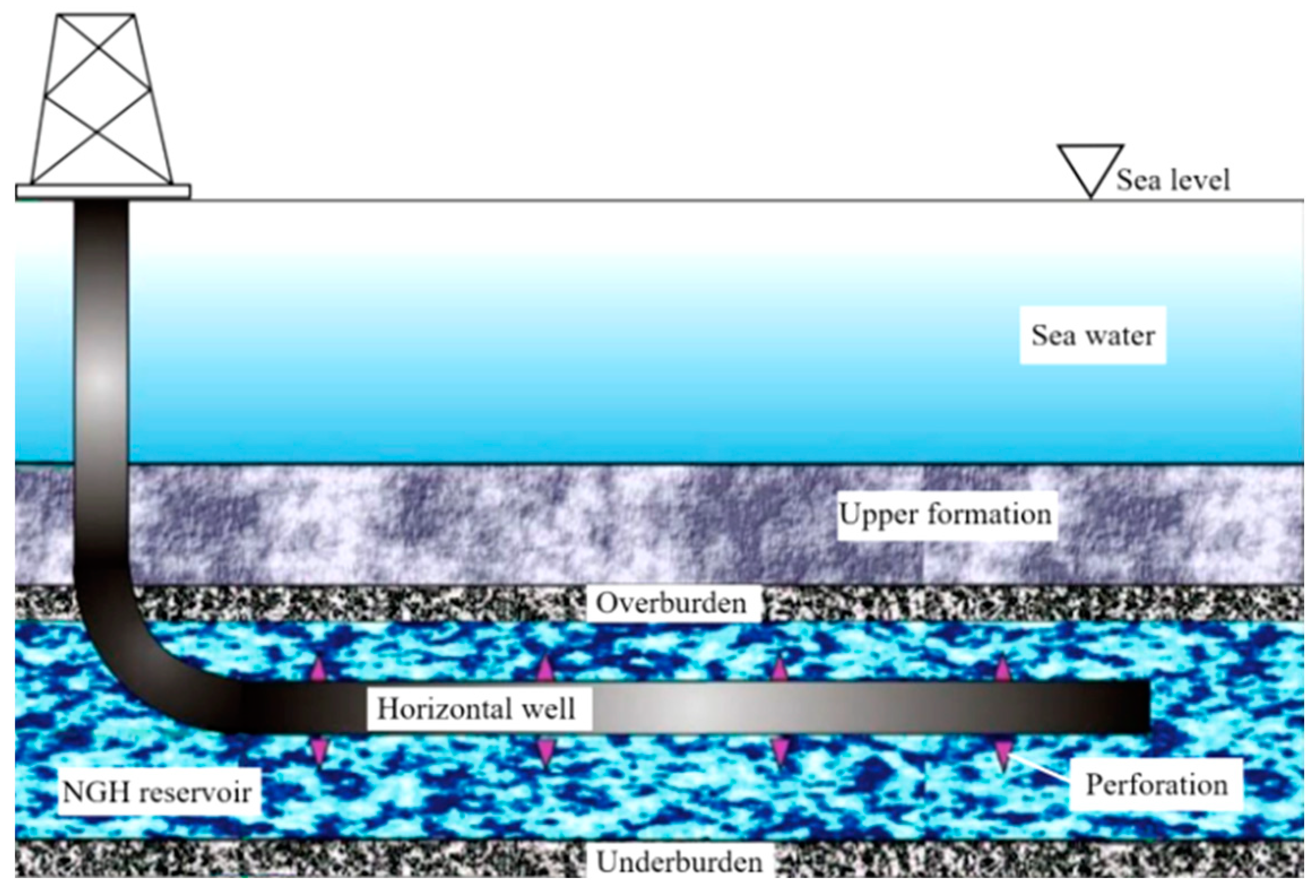
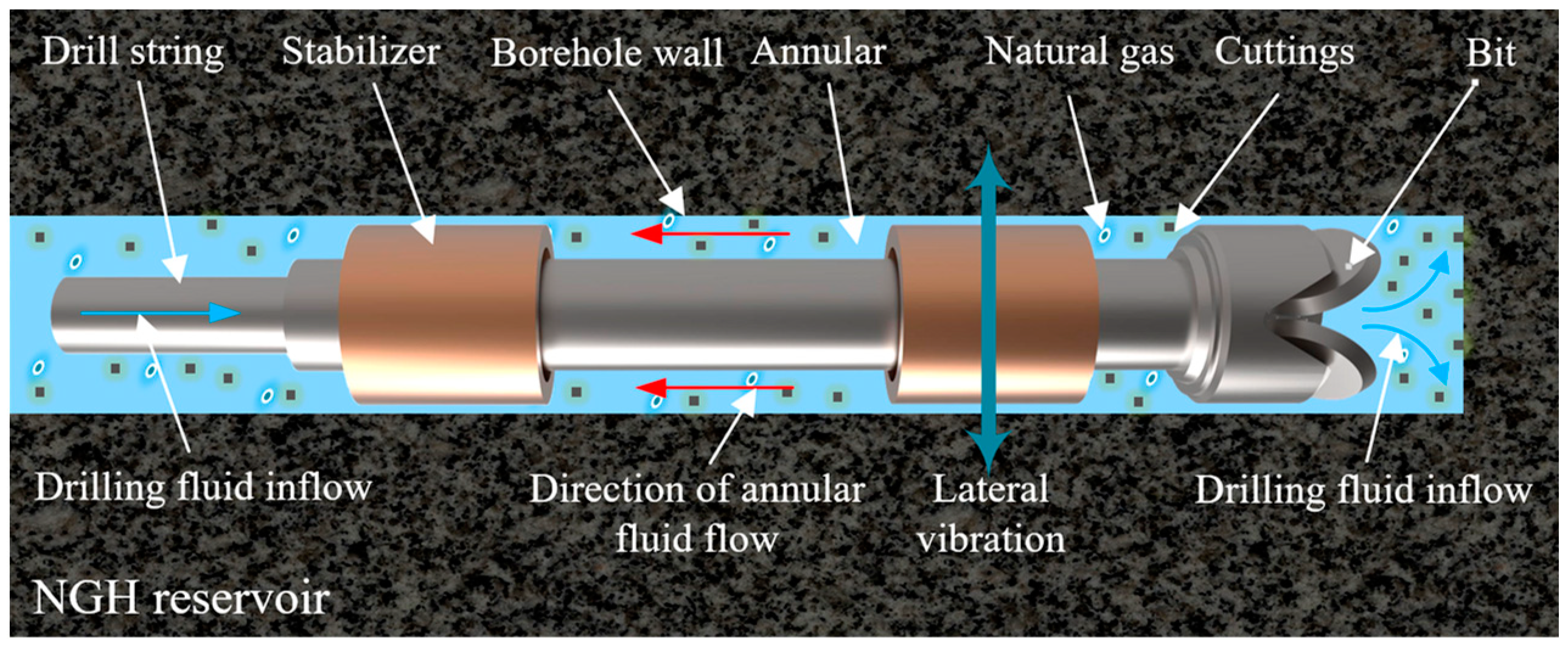
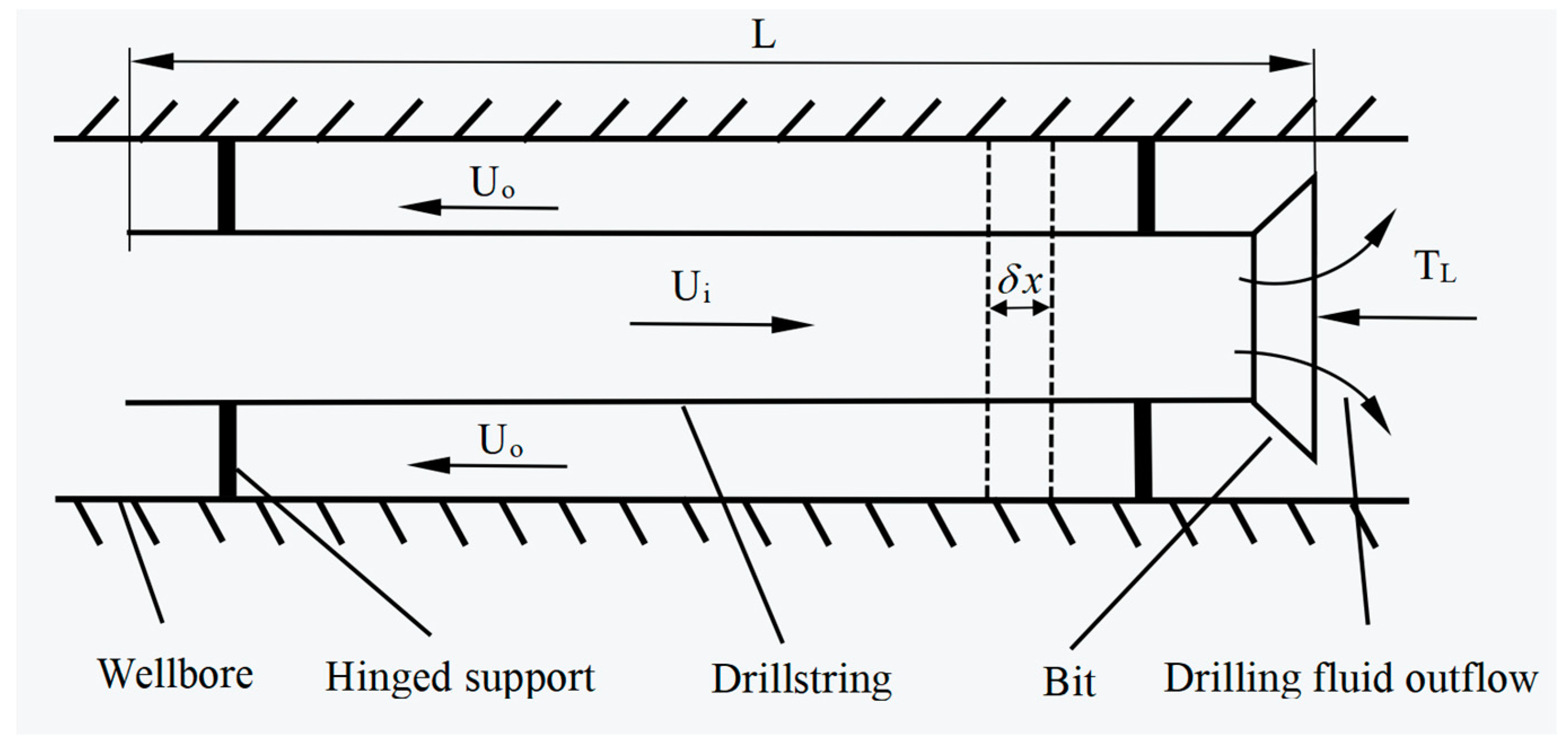


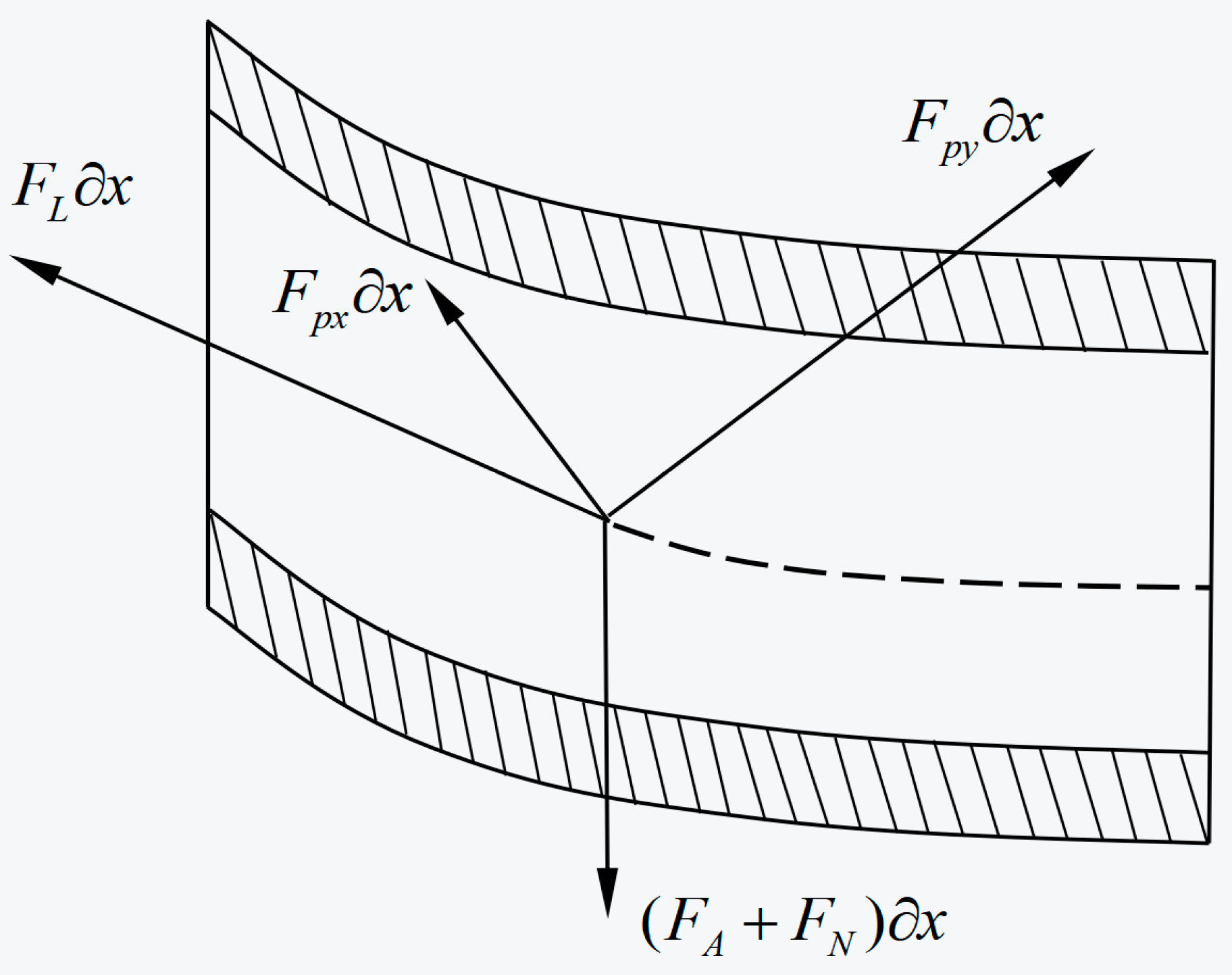
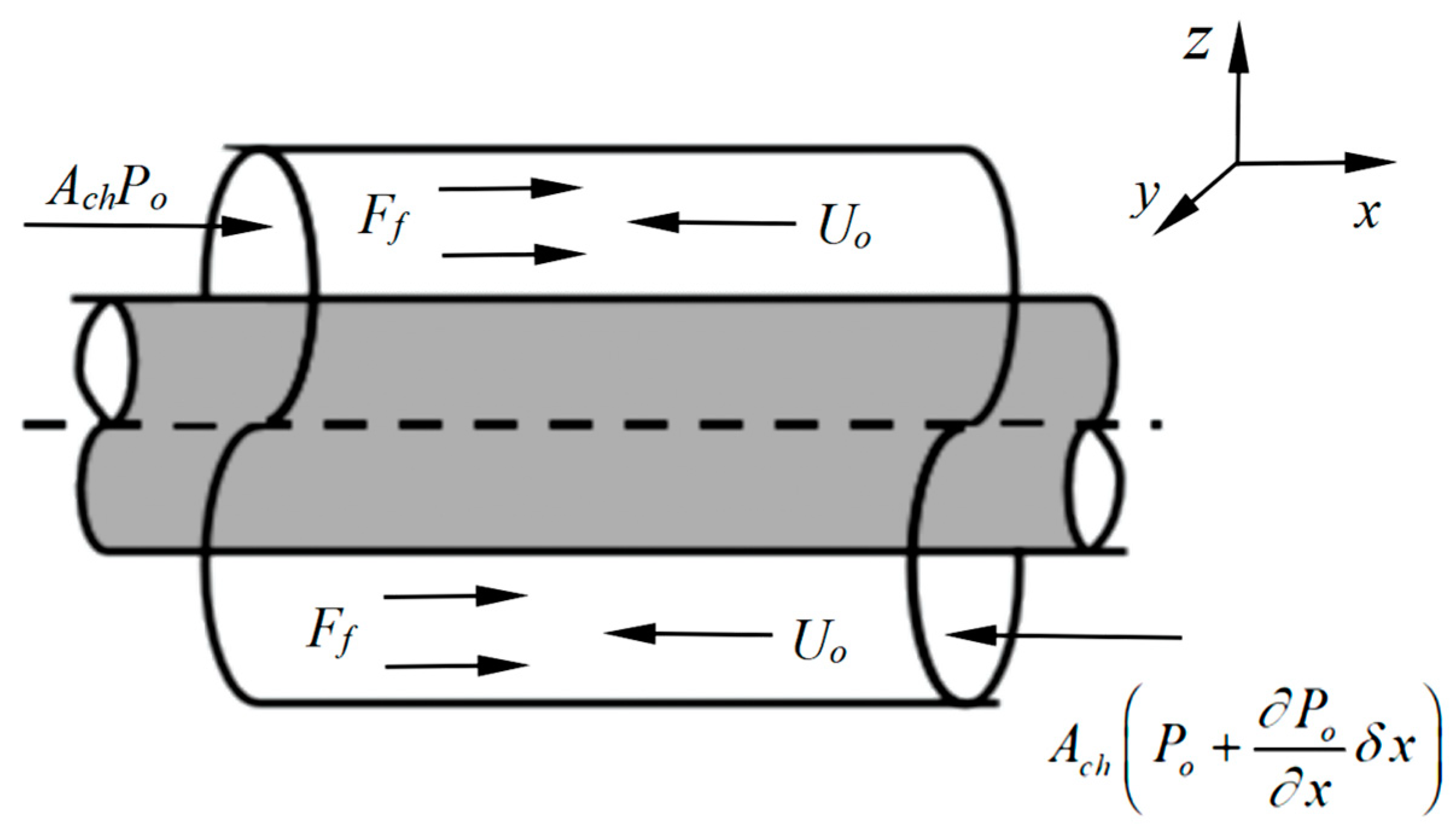
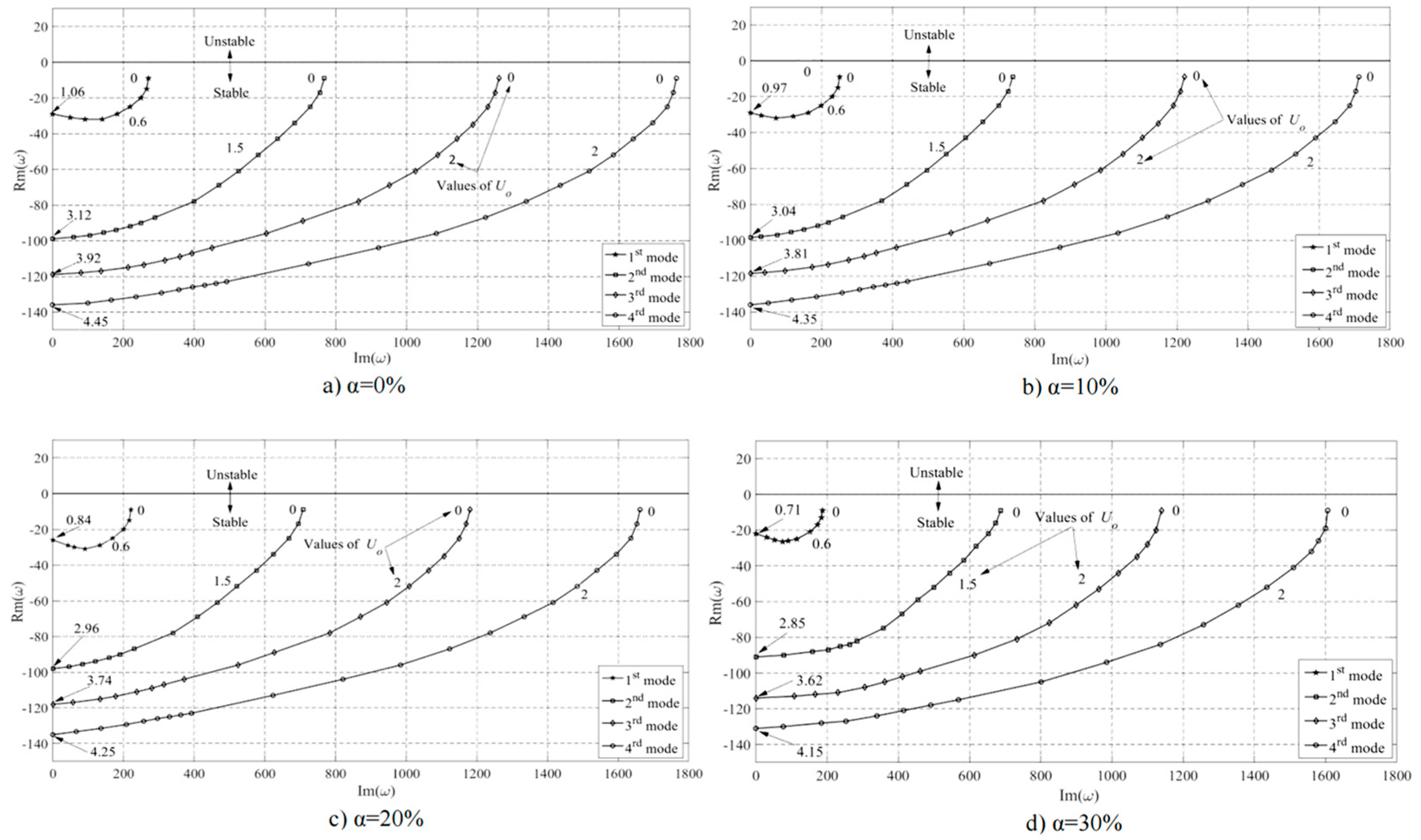
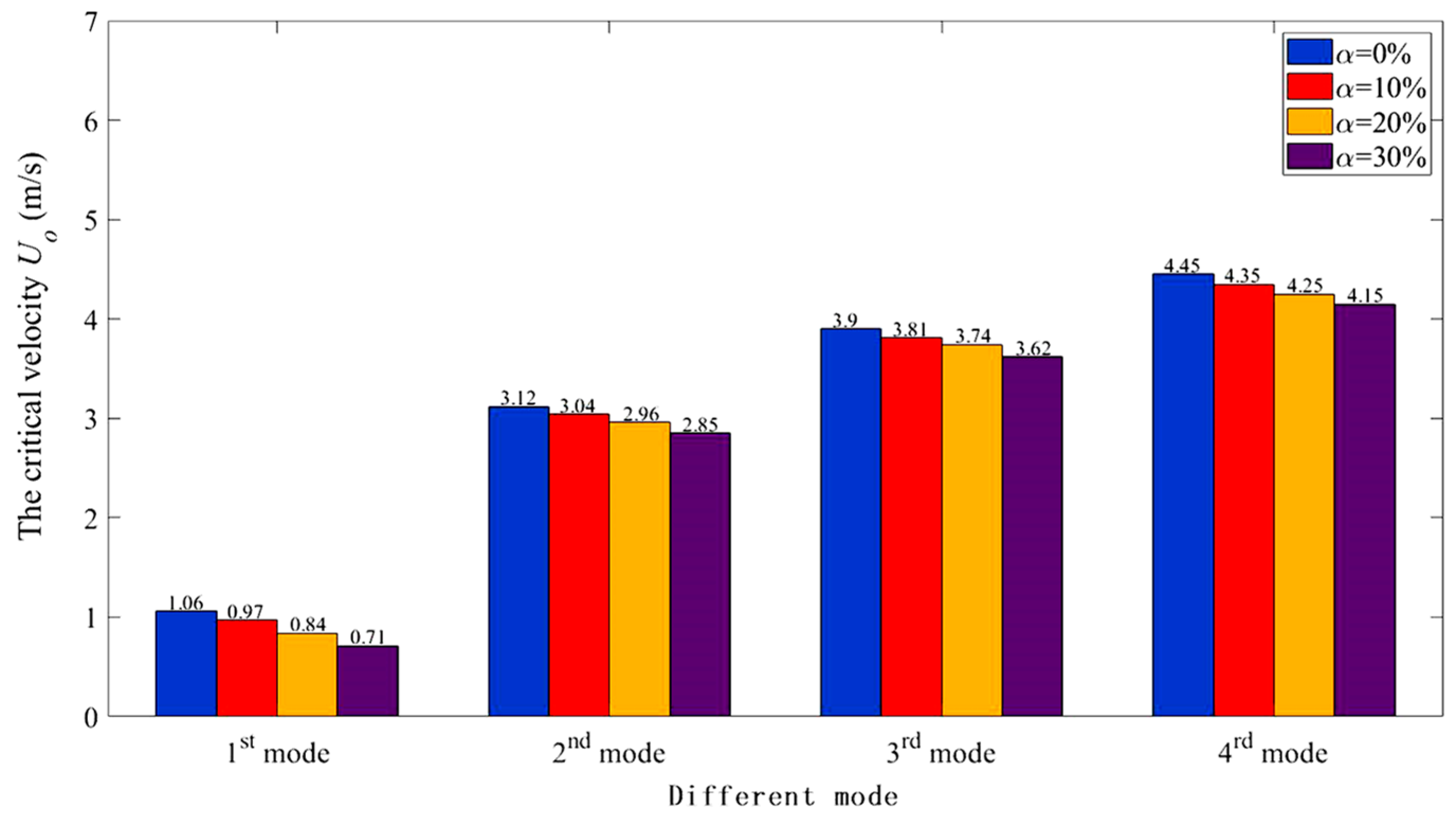

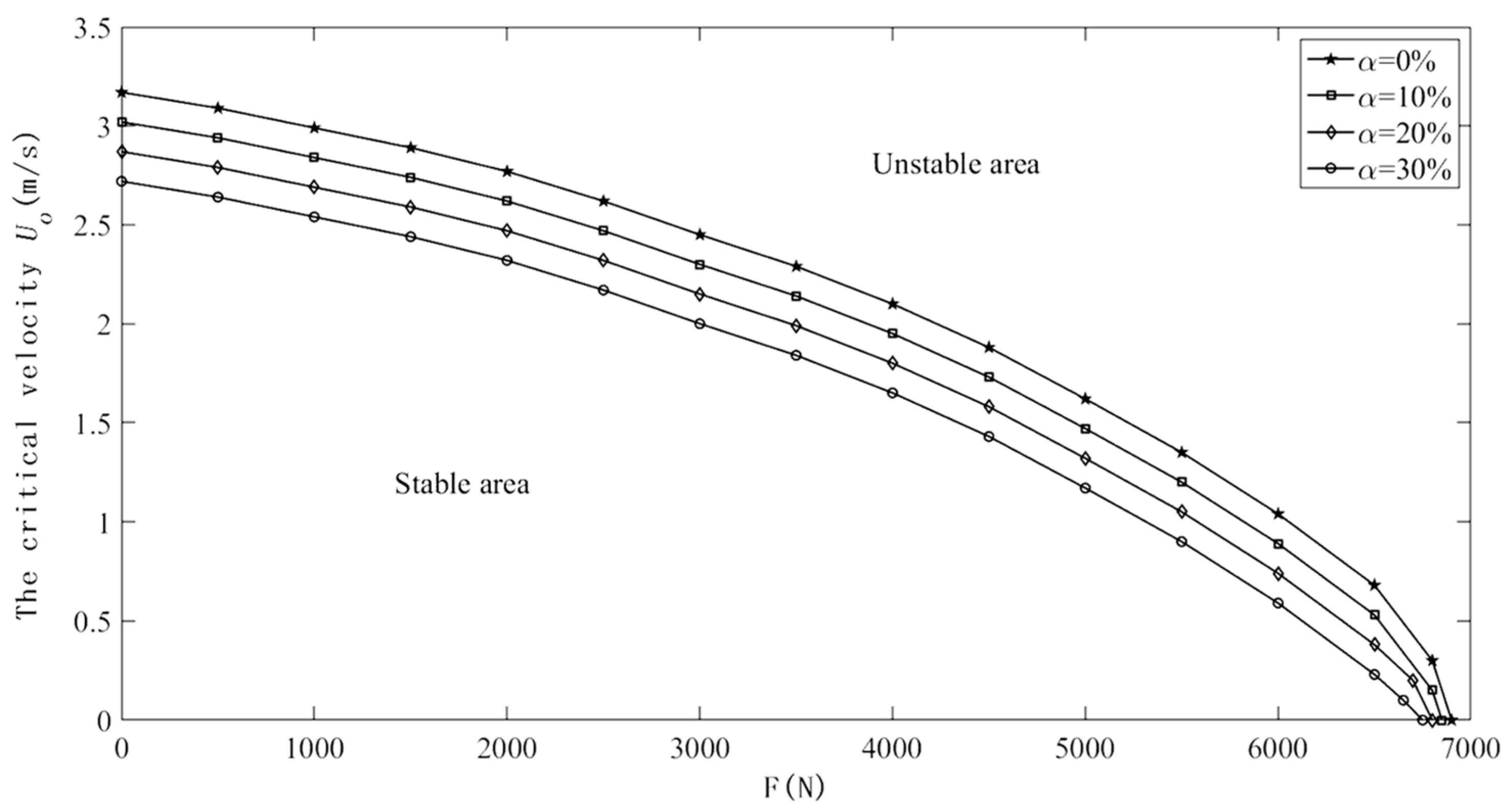

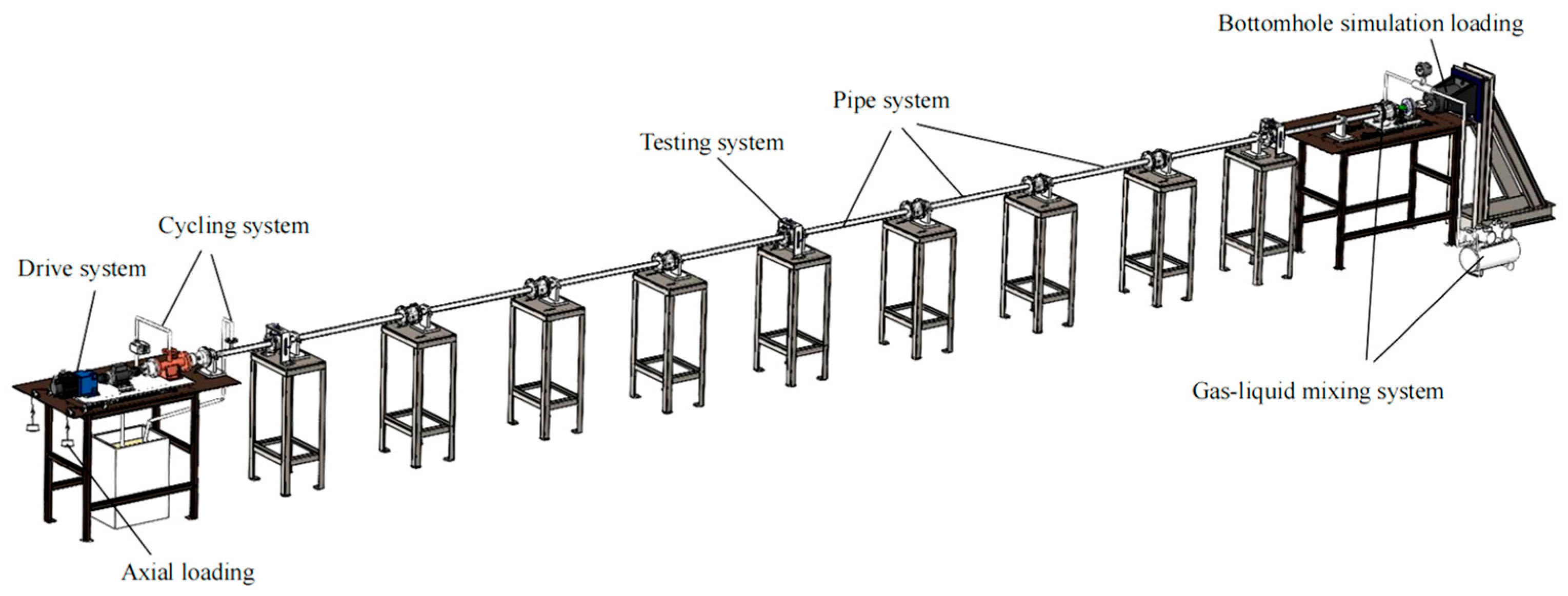
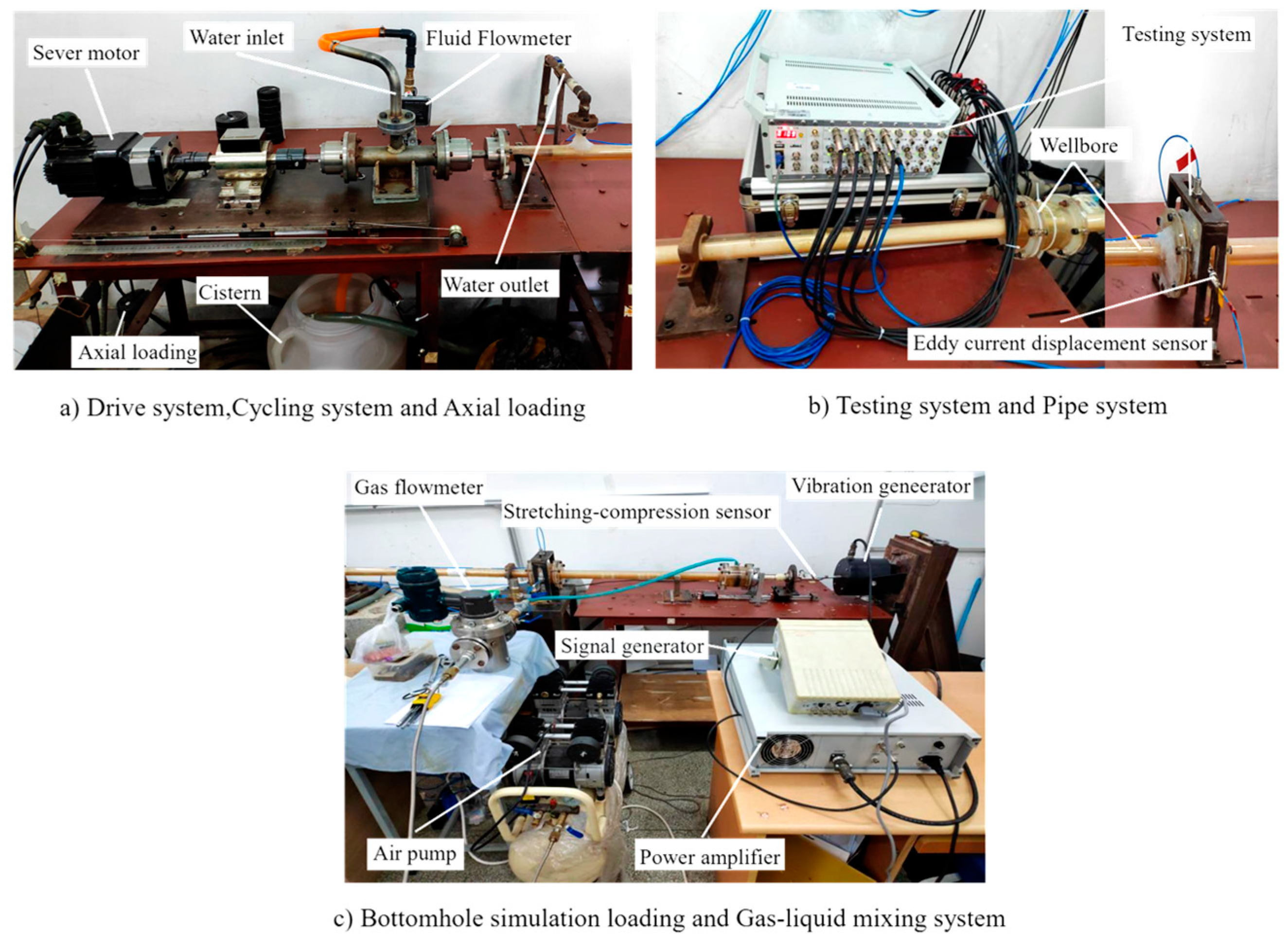
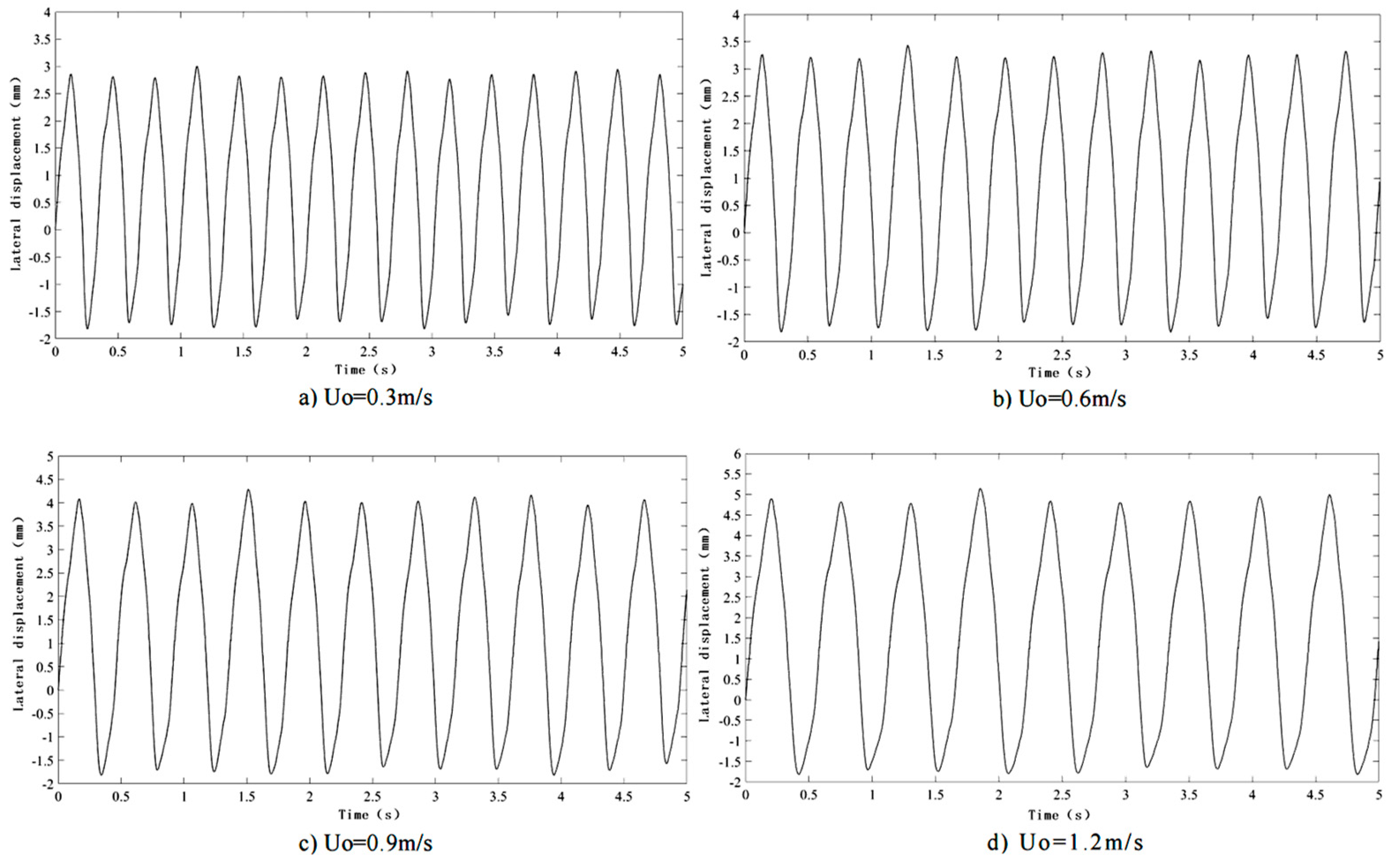
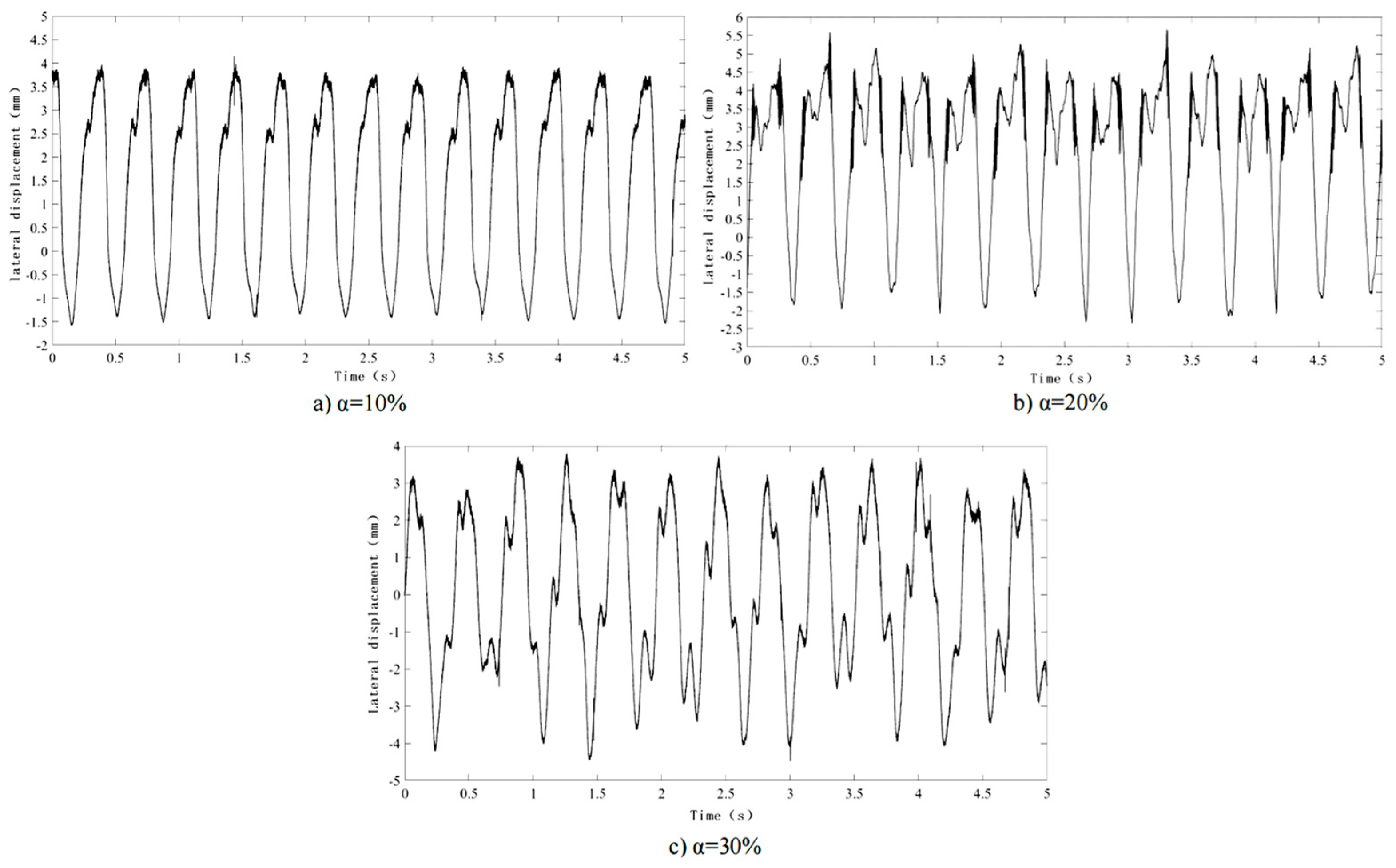
| Parameter | Value | Unit |
|---|---|---|
| L | 1000 | m |
| E | 207 | GPa |
| ρt | 7800 | kg/m3 |
| Di | 0.108 | m |
| Do | 0.127 | m |
| Mt | 27.35 | kg/m |
| Dch | 0.312 | m |
| ρi | 1200 | kg/m3 |
| ρg | 0.75 | kg/m3 |
| v | 10−6 | m2/s |
| Cf | 0.0125 | 1 |
| χ | 1.4 | 1 |
| Parameter | Dimensions |
|---|---|
| Density | ML−3 |
| Mass | M |
| Length | L |
| Force | MT−2 |
| Angular | T−1 |
| a1 | a2 | a3 | a4 | a5 | a6 | a7 | |
|---|---|---|---|---|---|---|---|
| M | 0 | 1 | 1 | 1 | 0 | 1 | 0 |
| L | 1 | −1 | −3 | 0 | 4 | 1 | 0 |
| T | 0 | −2 | 0 | 0 | 0 | −2 | −1 |
Disclaimer/Publisher’s Note: The statements, opinions and data contained in all publications are solely those of the individual author(s) and contributor(s) and not of MDPI and/or the editor(s). MDPI and/or the editor(s) disclaim responsibility for any injury to people or property resulting from any ideas, methods, instructions or products referred to in the content. |
© 2022 by the authors. Licensee MDPI, Basel, Switzerland. This article is an open access article distributed under the terms and conditions of the Creative Commons Attribution (CC BY) license (https://creativecommons.org/licenses/by/4.0/).
Share and Cite
Wang, B.; Wang, L.; Meng, X.; Ren, F. Effect of Annular Gas–Liquid Two-Phase Flow on Lateral Vibration of Drill String in Horizontal Drilling for Natural Gas Hydrate. Processes 2023, 11, 54. https://doi.org/10.3390/pr11010054
Wang B, Wang L, Meng X, Ren F. Effect of Annular Gas–Liquid Two-Phase Flow on Lateral Vibration of Drill String in Horizontal Drilling for Natural Gas Hydrate. Processes. 2023; 11(1):54. https://doi.org/10.3390/pr11010054
Chicago/Turabian StyleWang, Baojin, Liuci Wang, Xiangbo Meng, and Fushen Ren. 2023. "Effect of Annular Gas–Liquid Two-Phase Flow on Lateral Vibration of Drill String in Horizontal Drilling for Natural Gas Hydrate" Processes 11, no. 1: 54. https://doi.org/10.3390/pr11010054
APA StyleWang, B., Wang, L., Meng, X., & Ren, F. (2023). Effect of Annular Gas–Liquid Two-Phase Flow on Lateral Vibration of Drill String in Horizontal Drilling for Natural Gas Hydrate. Processes, 11(1), 54. https://doi.org/10.3390/pr11010054










